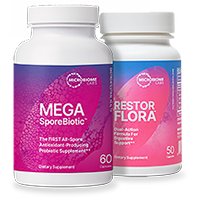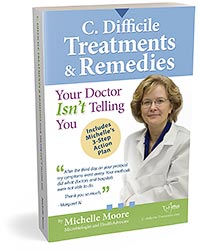C. difficile is very hard to kill because these bacteria form spores. Spores are like seeds. In nature, plant seeds lay dormant and protected from freezing and drought until just the right growing conditions occur. And just like seeds, C. diff. spores have a hard protective shell that acts like armor plating. These spore structures protect the bacteria inside from attack by treatments and disinfectants and allow them to stay dormant and survive for long periods of time.
 C. difficile spores spread through touch or contact with contaminated objects or surfaces, such as bathroom sink areas, toilet handles, cell phones, keyboards and more. Therefore, proper hygiene and hand washing is very important because ingesting either C. diff. bacteria or C. diff. spores can cause an infection, or a re-infection.
C. difficile spores spread through touch or contact with contaminated objects or surfaces, such as bathroom sink areas, toilet handles, cell phones, keyboards and more. Therefore, proper hygiene and hand washing is very important because ingesting either C. diff. bacteria or C. diff. spores can cause an infection, or a re-infection.
One way to help prevent the spreading of C. diff. is by proper hand washing by all family members, most especially before eating. But let’s first discuss why C. difficile is so hard to control.
C. difficile Spores
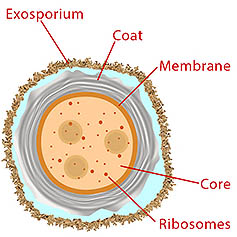
C. difficile spore cross-section diagram
These spores are a protective shell that most disinfectants cannot break open.
In studies, C. difficile spores have been shown to survive on hard surfaces for at least 5 months 1, 2.
C. diff. spores are heat resistant and it’s possible for spores to survive for years in a state similar to hibernation.
Because of these resistant spores, it takes stronger disinfectants and longer “contact time” to effectively destroy them. Many disinfectants, including most bleach products require 5 to 10 minutes that the surface must remain wet in order to kill the spores. Not all surfaces are compatible with disinfectants, so cleaning and/or sanitizing can help these surfaces. See further below for a list of disinfectants that kill C. difficile spores.
Thankfully, even basic cleaning provides a great benefit when it comes to reducing C. difficile bacteria and their spores. Even though cleaning does not kill C. diff. spores, it helps physically remove them from the area by washing them away. Depending on the situation, both cleaning and disinfecting have a time and a place in controlling C. diff. in the home.
Cleaning vs. Disinfecting vs. Sanitizing
If you want to reduce the risk of C. diff. spreading through your home, then you need to understand the differences between cleaning, disinfecting and sanitizing. All three methods are important for controlling C. diff., but they provide very different results. Cleaning the wrong way can increase the risk of spreading C. difficile and over-using toxic disinfectants can expose your body and immune system to unneeded risks.
Cleaning
 Cleaning means to remove contamination from a surface, using some type of soap or detergent. It’s important to note that cleaning generally does NOT kill any of the bacteria that may be present on the surface. Cleaning can physically lift bacteria off of a surface so that it’s easier to wipe the C. difficile bacteria away. Cleaning does not kill bacteria or spores and it does not remove all of the bacteria or spores.
Cleaning means to remove contamination from a surface, using some type of soap or detergent. It’s important to note that cleaning generally does NOT kill any of the bacteria that may be present on the surface. Cleaning can physically lift bacteria off of a surface so that it’s easier to wipe the C. difficile bacteria away. Cleaning does not kill bacteria or spores and it does not remove all of the bacteria or spores.
Cleaning is the first step that comes before sanitizing or disinfecting. Dirt and grime protect C. diff. bacteria from the antimicrobial action of a disinfectant or sanitizer. Cleaning removes the dirt on the surface so a sanitizer or disinfectant will be more effective.
Disinfecting
 Disinfecting means to kill bacteria or spores on a surface. However, disinfecting does NOT remove bacteria or other contaminants, so it does not “clean” the surface. Most disinfectants have to be mixed and used in a very specific way to work properly.
Disinfecting means to kill bacteria or spores on a surface. However, disinfecting does NOT remove bacteria or other contaminants, so it does not “clean” the surface. Most disinfectants have to be mixed and used in a very specific way to work properly.
When it comes to C. difficile, it’s important to use the right disinfectant product that will control C. diff., and use it correctly. Most disinfectants are harsh and harmful to your health and weaken your immune system if used improperly, too often or for too long a period of time. Therefore, it’s best to limit their use to high risk areas.
Sanitizing
 Sanitizing means to reduce the number of bacteria on a surface. However, sanitizing does not clean a surface or kill all bacteria. While sanitizing is beneficial for lowering the numbers of bacteria on low-risk surfaces, it will not kill or control C. diff. spores.
Sanitizing means to reduce the number of bacteria on a surface. However, sanitizing does not clean a surface or kill all bacteria. While sanitizing is beneficial for lowering the numbers of bacteria on low-risk surfaces, it will not kill or control C. diff. spores.
Sanitizers are also not meant for cleaning dirt, grime or debris of any kind, for which a cleaning agent is best suited. What sanitizers CAN do is reduce the risk of many kinds of bacteria and viruses spreading around the home. They are also convenient, easy to use and are generally safer to be around than disinfectants. Sanitizers are also ideal for use while traveling or on the go.
Best Practices for Home C. diff. Control
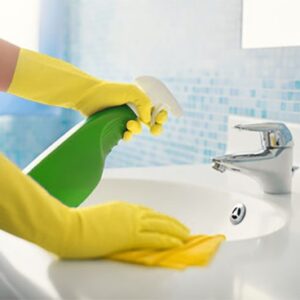 Cleaning and/or sanitizing is the best overall option for controlling bacteria on the majority of home surfaces and objects. However, for high-risk objects, high-touch objects or objects and surfaces near or in contact with an infected person, a disinfectant is usually best.
Cleaning and/or sanitizing is the best overall option for controlling bacteria on the majority of home surfaces and objects. However, for high-risk objects, high-touch objects or objects and surfaces near or in contact with an infected person, a disinfectant is usually best.
Cleaning is the best option for lower risk surfaces like floors, counter tops, furniture, toys, and pet care products, just to name a few. Your cleaning efforts should focus on lower risk surfaces, especially any surfaces that are visually dirty. Importantly, note that a surface must be cleaned to remove visible dirt and debris BEFORE disinfecting or sanitizing the surface.
Avoid traditional mops and sponges, as they are a breeding ground for bacteria and just spread bacteria all over the place. It’s better to use mops with replaceable cleaning heads that can be discarded (or disinfected) after each use. And it’s best to disinfect your sponge or use a new sponge for each cleaning when it comes to C. diff.
For disinfecting, focus on high risk areas, especially during the diarrhea stage of a C. diff. infection3. High risk surfaces include the infected person’s toilet seat, toilet handle and all outside toilet surfaces. The bathroom sink and faucet, shower, floor and tub of an infected person are also high risk surfaces. Surfaces or objects that are close to or in contact with someone who has C. difficile should also be a focus of disinfection, including the infected person’s table, chair, furniture, light switches, doorknobs, dresser handles, remote control, phone, computer keyboard, and personal care product bottles.
Which Disinfectants Kill C. diff. Spores?
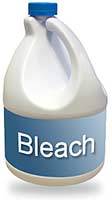 Bleach products are the most common disinfectants capable of killing C. difficile spores4. Bleach products are readily available and they are easy to find in small amounts suitable for household use. However, bleach is corrosive and caustic, and there are many different products that contain bleach, but only some are proven to kill C. diff. spores.
Bleach products are the most common disinfectants capable of killing C. difficile spores4. Bleach products are readily available and they are easy to find in small amounts suitable for household use. However, bleach is corrosive and caustic, and there are many different products that contain bleach, but only some are proven to kill C. diff. spores.
A product must have an EPA-registered claim against C. difficile spores in order to be effective. The product must also be used in a specific way as spelled out by the manufacturer to kill spores. Most bleach products require 5 to 10 minutes of wetted “contact time” with the surface to kill C. diff spores.
As you can see in the tables on the EPA webpage at the link below, there are at least 54 disinfectants that are registered to kill C. diff. spores that are meant for residential or home uses:
EPA’s Registered Antimicrobial Products Effective Against Clostridioides difficile (C. diff) Spores [List K]
Germicidal Wipes for C. difficile
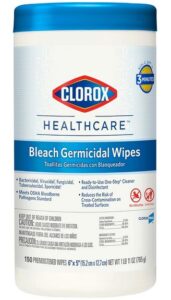 Many people like the convenience of germicidal wipes for disinfecting toilets, faucets, door knobs and other high-risk surfaces. There’s no diluting of bleach with water to the right concentration. Simply grab a wipe and go.
Many people like the convenience of germicidal wipes for disinfecting toilets, faucets, door knobs and other high-risk surfaces. There’s no diluting of bleach with water to the right concentration. Simply grab a wipe and go.
Clorox Healthcare Bleach Germicidal Wipes are one such product that indicates it kills C. difficile spores with a contact or “wet” time of 3 minutes. Here’s the product listing at Amazon.
This page contains affiliate links, read our affiliate policy.
Bleach Alternatives that Kill C. diff Spores
You’ll see on the EPA list above, there are alternatives to bleach, but most of them are for hospital and other professional uses and are difficult to find. One alternative to bleach uses hydrogen peroxide or other peroxides in combination with surfactants, acids and other enhancing ingredients. Peroxide disinfectants can be clear and colorless and have less of a strong odor than bleach. Below are two peroxide disinfectants with stated kill times for C. diff. spores. Update: as of 2024 these products do not appear to be available on Amazon.
▪The EcoLab Virasept product has a 10 minute kill time for C. diff. spores. This product has an HMIS safety rating of 3, 0, 0 for Health, Flammability and Reactivity, respectively, which is the same as regular bleach.
▪ Another peroxide disinfectant is PeridoxRTU made by CRC. This product has a 3 minute kill time for C. This product has an HMIS safety rating of 2, 0, 0 for Health, Flammability and Reactivity, respectively.
Safe and Effective Disinfectant Alternatives
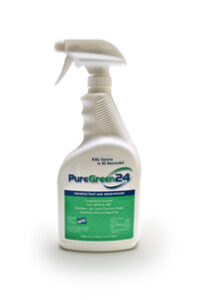 While it’s very important to disinfect high-risk surfaces in your home with a spore killing disinfectant, why not use a less toxic and safer disinfectant for lower risk surfaces?
While it’s very important to disinfect high-risk surfaces in your home with a spore killing disinfectant, why not use a less toxic and safer disinfectant for lower risk surfaces?
Disinfectants made with silver ions are very effective against a wide range of bacteria, viruses, yeast and molds. These disinfectants are also economically priced, very safe and easy to use. Silver disinfectants can be used anywhere you’d normally use another type of disinfectant and are much better on the environment and your immune system. It’s also safe to use around children and animals and it can even be used to disinfect toys.
PureGreen24 is one of the our favorite disinfectants and it contains only silver ions (Silver Ion SDC technology), citric acid and water. This disinfectant has a two minute proven kill time for many common infectious bacteria found in the home.
NOTE: this is a non-toxic disinfectant but it will NOT kill C. diff. spores. It is not ideal for disinfecting high-risk surfaces contaminated with C. difficile. You can find it on Amazon.
This page contains affiliate links, read our affiliate policy.
Summary
The EPA lists predominantly bleach containing products that will kill C. difficile spores. Be sure to clean surfaces with soap and water before using a disinfectant proven to kill C. difficile spores. Cleaning and/or sanitizing lower risk surfaces helps lower the amount of dirt and bacterial contamination.
Because bleach disinfectants carry their own health risks, focus on disinfecting high-risk areas and clean or sanitize lower-risk areas.

About the Author – Michelle Moore, BSc
Michelle Moore is a microbiologist, holistic health educator, and author of C. difficile Treatments & Remedies. With over 10 years of experience in pharmaceutical research and over 20 years in natural medicine, she helps people overcome C. difficile and other chronic infections naturally.
References
- Clostridium difficile spore germination: an update., Res Microbiol. 2010 Nov;161(9):730-4.
- Isolation of Clostridium difficile from the environment and contacts of patients with antibiotic-associated colitis, J Infect Dis. 1981 Jan;143(1):42-50.
- Clinical and cost effectiveness of eight disinfection methods for terminal disinfection of hospital isolation rooms contaminated with Clostridium difficile, Doan L, J Hosp Infect. 2012 Oct;82(2):114-21.
- Reduction of Clostridium difficile Infection in a Community-based Hospital Using Hypochlorite Solution AJIC: June 2005, Volume 33, Issue 5, Pages e43-e44.


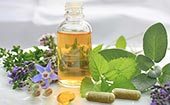
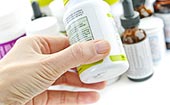

 Fill in the form below to get our C. diff. tips newsletter and your free report “10 Things You Need to Know to Overcome C. difficile”.
We value your Privacy. Your email will be kept strictly confidential & secured. See our
Fill in the form below to get our C. diff. tips newsletter and your free report “10 Things You Need to Know to Overcome C. difficile”.
We value your Privacy. Your email will be kept strictly confidential & secured. See our 